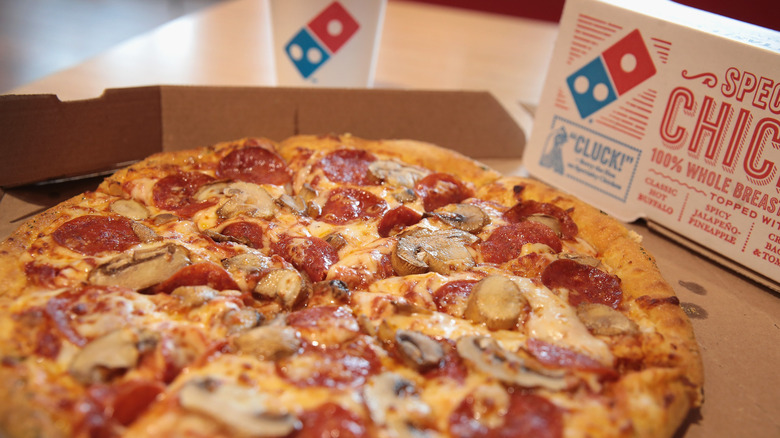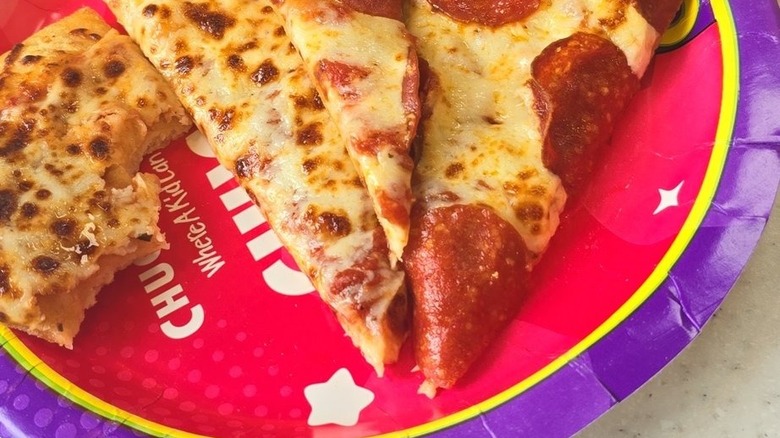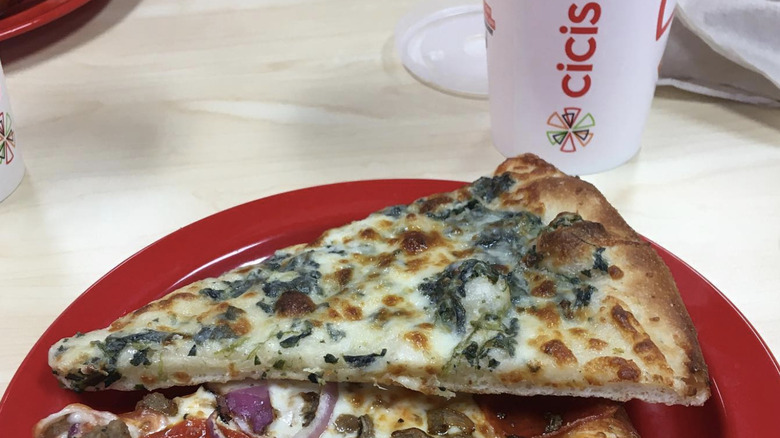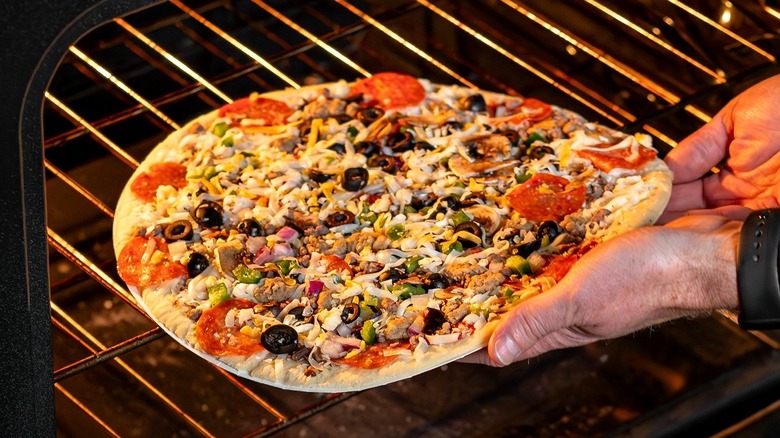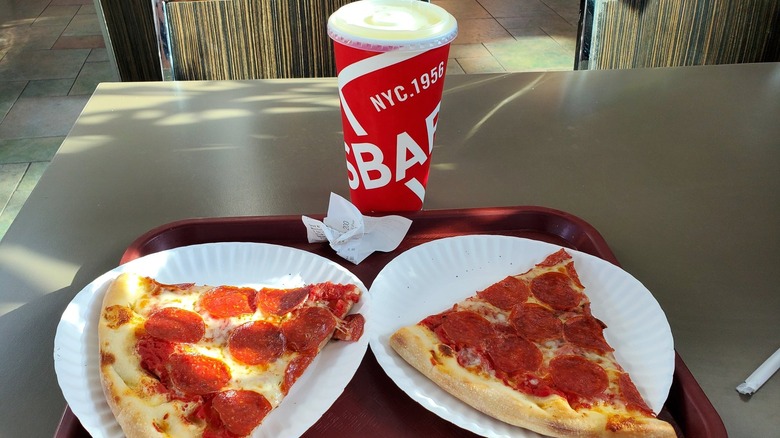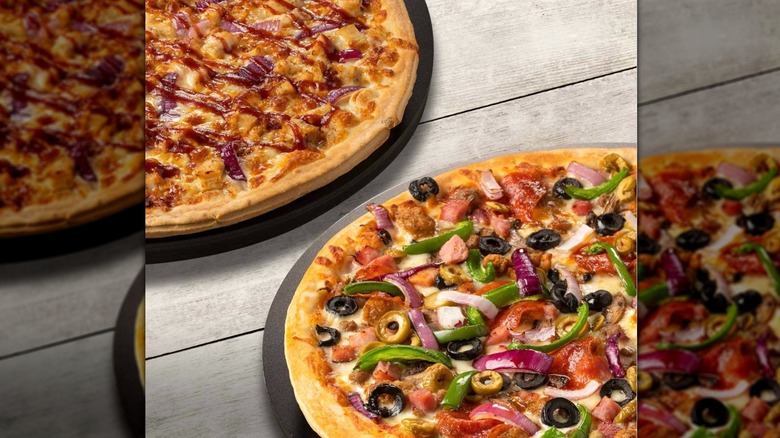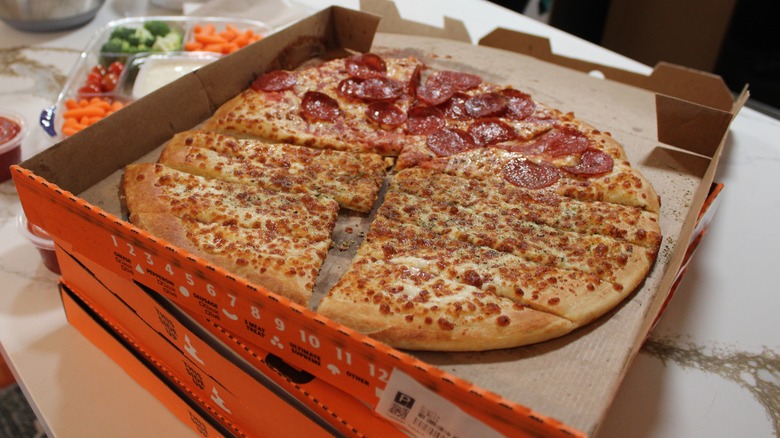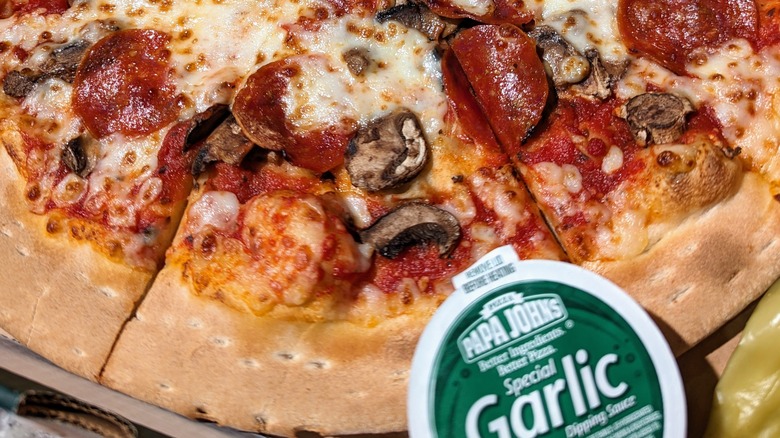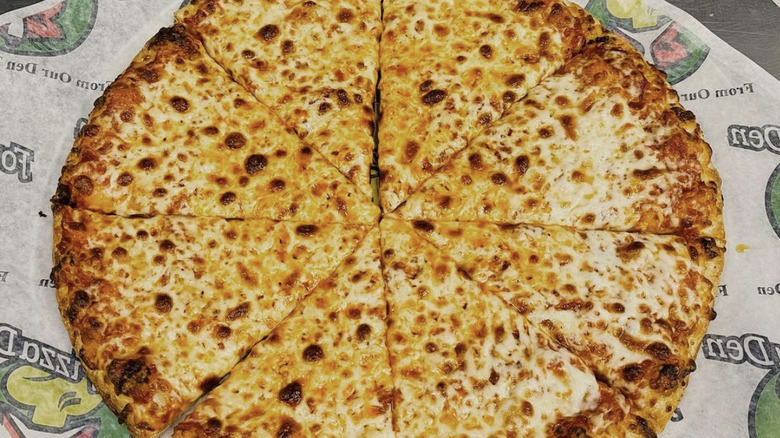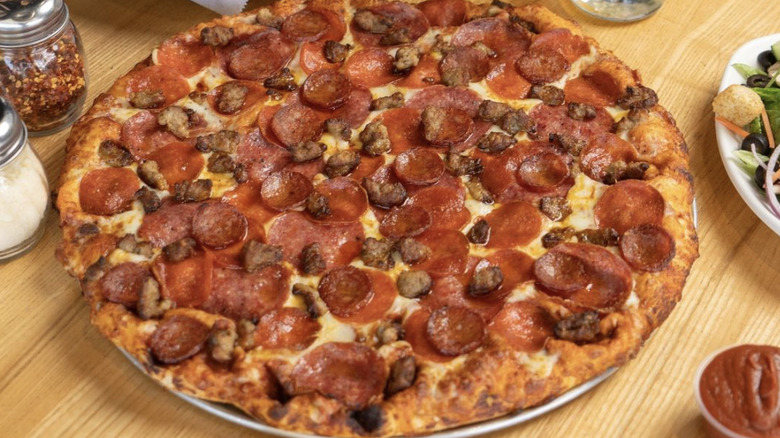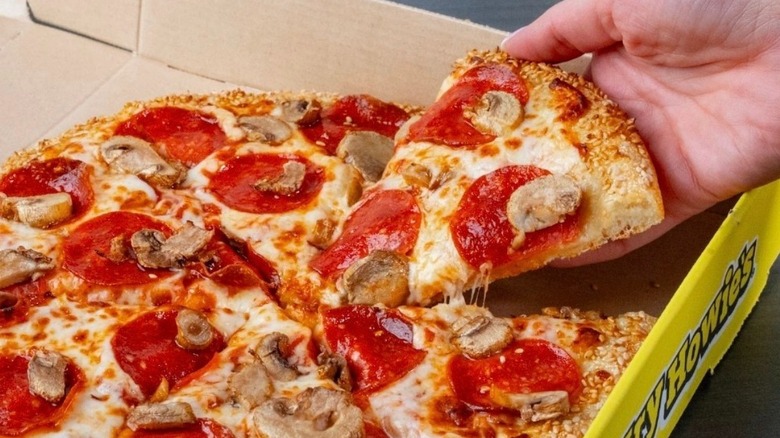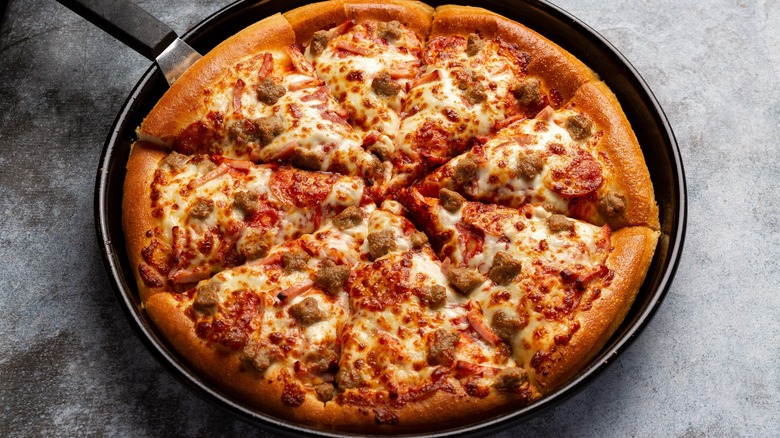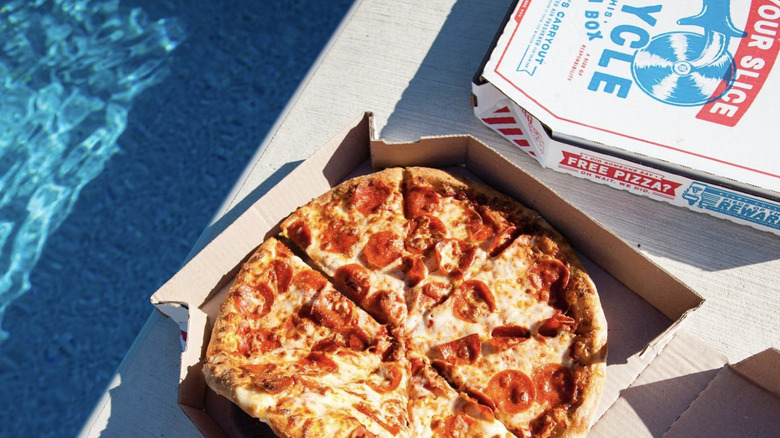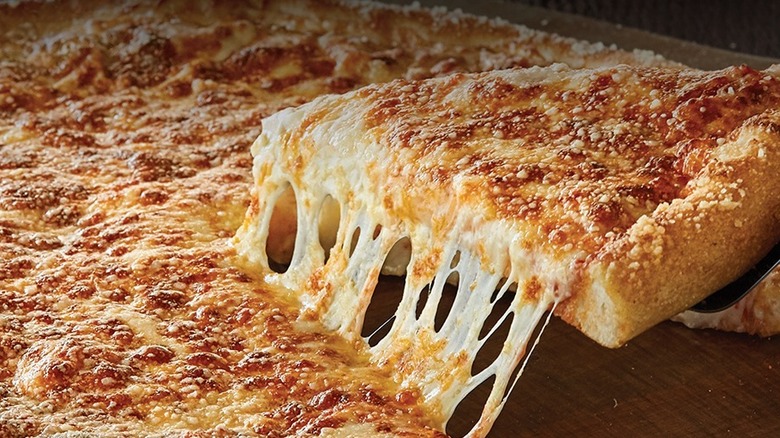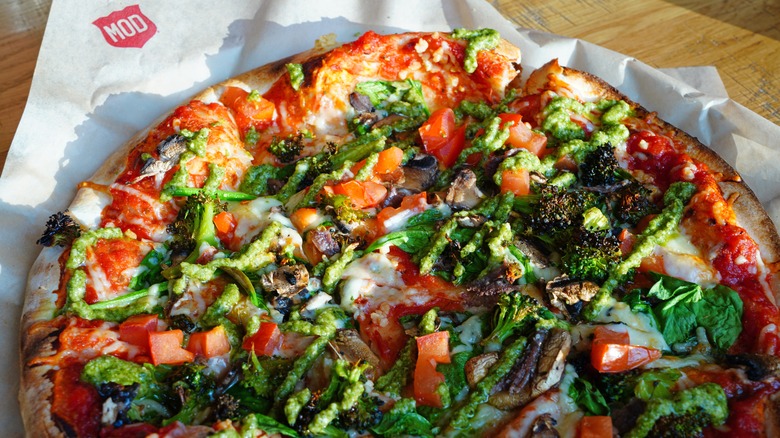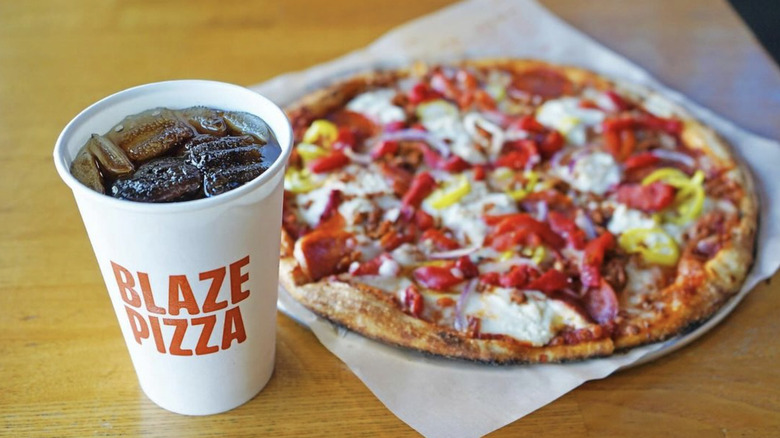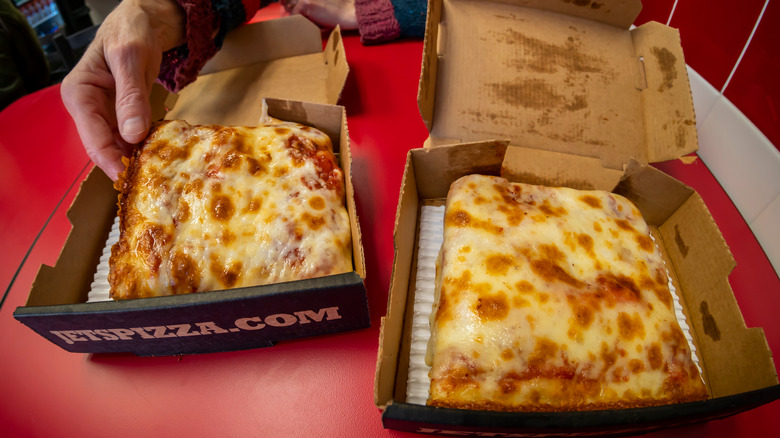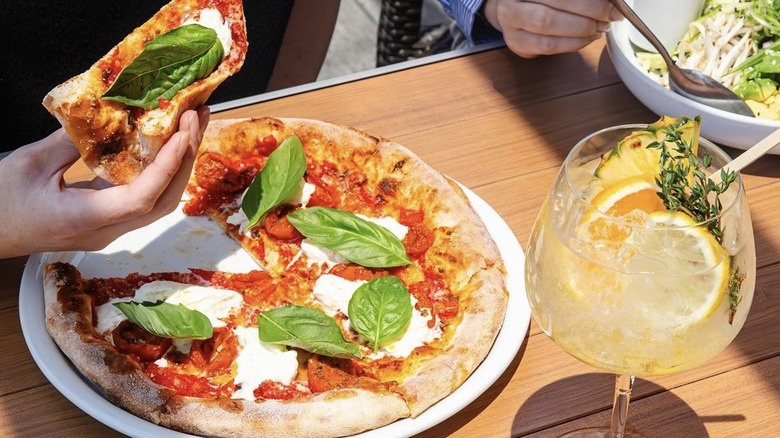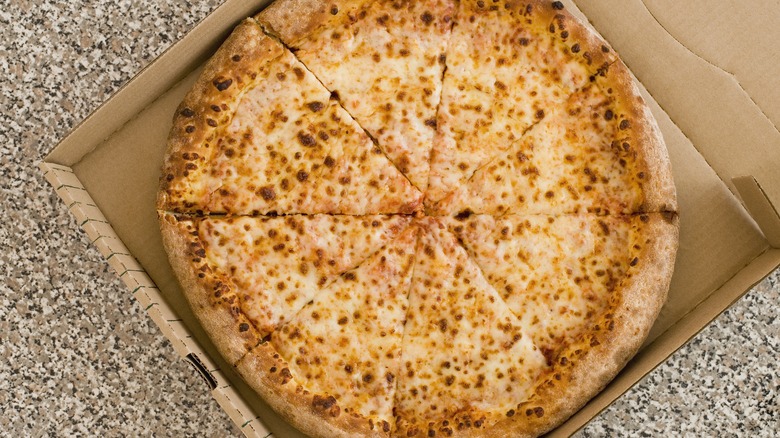The Best And Worst Chain Pizza Restaurants, Ranked
Almost everybody loves pizza, and with good reason. Pizza can be prepared hundreds of ways, with regional styles, crust preferences, and topping choices all factoring in to provide a mind-boggling variety as well as inspiring some strong opinions about what makes a good pie. Every major pizza chain prepares its signature dish a little bit differently from the competition, and they all win loyal customers who keep them and their pizza-making methods in business indefinitely. But pizza fans aren't as loyal as we thought, and true fans of the dish will check out other chains if they feel that they've got something to offer.
At the end of the day, some pizza chains are just better than others, because they nail the musts of a quality pie. Here then is our ranking of the most prominent pizza chains, from worst to best.
17. Chuck E. Cheese
It's likely that nobody goes to Chuck E. Cheese specifically for the pizza. It's an entertainment destination; a place for kids to have fun or celebrate their birthdays, what with the arcades and animatronic rock band. But you have to feed all those kids something, and that something is pizza — per the loosest definition. Chuck E. Cheese's pizza is an afterthought because it doesn't need to be important. It's at a generic, third-rate frozen pizza level, which is why it makes sense that Chuck E. Cheese now has a frozen pizza.
During COVID-19 pandemic lockdowns, when nobody could go to a Chuck E. Cheese for the video games and parties, the company resorted to using the name of one of its animatronics on delivery apps. But the survival technique of "Pasqually's Pizza" offered up the same cardboard crust, ketchup-adjacent sauce, and cheese that doesn't taste like cheese as its brick-and-mortar counterpart.
14. Cici's
By the very nature of how it operates, it would be tough for Cici's to consistently offer well-made pizza made from top quality ingredients to its customers. Its primary function is an all-you-can-eat pizza buffet, marketed as a way to get a lot of food on a budget. Some days of the week, customers can consume all the pizza they want for only $4.99. To eke out a profit at such a cut-rate price point, Cici's clearly has to keep everything that goes into its wide array of pizza as cheap as possible.
The chain clearly doesn't waste a lot of money on dough or excessive toppings. Cici's serves up one buffet pizza after another that has a thin crust that tastes like a saltine (with the salt removed) and topped with as little gloopy cheese, greasy meat chunks, and soggy veggies as possible. Cici's pizza is reminiscent of bad school lunch pizza, served semi-warm under light bulbs, but at least you can try different styles at the buffet until you can find the one that's somewhat palatable.
16. Papa Murphy's
The reason why restaurant-prepared pizza tastes so good is because it's baked in an intensely hot pizza oven, which makes for a nicely-done crust and gooey, bubbling cheese. By that logic, a Papa Murphy's customer will always get a mediocre pizza because of the chain's baffling business model. Papa Murphy's is the United States' biggest "take and bake" pizza chain — they assemble full pizzas, sell them raw, and leave it to the customer to cook it up themselves at home, in their standard ovens which simply can't reach a level of heat or pizza-accommodation as can a restaurant appliance.
A large-sized take and bake pizza costs around $9 to $19, or just a little less than what a competing parlor may charge for a fully-cooked pie. But it's not worth the savings when the product is necessarily going to turn out sub-par. The best homemade pizzas are the easiest to make, which makes Papa Murphy's and its already bland pizzas totally unnecessary.
15. Sbarro
Sbarro isn't a destination pizza joint. When malls dominated the retail landscape in the 1980s and 1990s, food courts had to feed hungry shoppers, and Sbarro took its place as the requisite pizza joint in thousands of shopping centers. Selling pizza by the slice, as well as Italian-American-adjacent items like breadsticks and spaghetti with meatballs, Sbarro didn't have to be good because it didn't have any immediate competition; it just had to sell passable pizza in big servings.
And today, as Sbarro soldiers on in remaining malls and at gas stations and convenience stores, it still sells its pizza to people with low expectations. Sbarro has exactly one pizza worth ordering, but all of them feel extra-doughy, slathered with a sauce that's too heavy on the garlic, and topped with cheese and meats that all congeal into a powerfully and visibly greasy mess the longer a slice sits under a heat lamp.
13. Pizza Ranch
With hundreds of locations mostly in the Midwest, Pizza Ranch tries to be too many things at once, and when restaurants lack focus, the quality of the food can suffer. Pizza Ranch is a pizza place, but it's also very proud of its fried chicken, and it serves both of those things in mass quantities on a grand central buffet. This one adheres to the Old Country Buffet style, with heaping trays full of passable mashed potatoes, fries, and chicken, right alongside numerous pizza offerings. The whole thing feels inexplicable, and it's also overpriced. A buffet is supposed to be money efficient, but Pizza Ranch charges about $18 for one lunch buffet trip, or what one modest pizza might cost at one of the bigger chains. If the food was better, particularly the pizza, it might be worth the price of admission.
As for the pizzas, the toppings are plentiful, particularly on the towering veggie-stocked Prairie and the Texan Taco. The downside is that when a weighty pizza is left to sit out under a buffet, it quickly gets cold, soggy, and bogged down. If these are the pizzas one can purchase on their own from Pizza Ranch, the buffet makes for a poor marketing medium.
12. Little Caesars
The pizza field is a crowded one, and each chain has to find its own unique angle to survive, and for Little Caesars, that niche is convenience. From its "Pizza Portal," where customers can grab their pre-ordered pizza and leave, to how it just keeps cheese and pepperoni pizzas "Hot-N-Ready" — rolling out of hot ovens so they're literally ready to go and up for grabs during peak dinner hours — Little Caesars cares more about getting the pizza out the door then it does about making an exemplary fast food pizza.
That being said, the crust is doughy on the inside and crispy on the outside due to a healthy layer of cooking fat, while the toppings are meager, the cheese is greasy, the sauce candy-sweet, and everything just ends up tasting like salt. There are a lot of discontinued Little Caesars items we wish would return, as what it currently offers, a Detroit-style inspired standard offering, are at least as cheap as they are convenient, running just about $7 to $8.
11. Papa Johns
Every box that leaves Papa Johns contains two free pieces of foreshadowing to let the customer know that the pizza they're about to eat is going to be mediocre at best, more specifically dry and lacking spicy heat. That signature cup of Papa Johns garlic-flavored faux-butter dipping sauce is necessary to slather atop the bland, flavorless crust to make it edible or have any taste at all; the pepperoncinis may provide a tiny bit of spiciness that would usually be afforded by the pepperoni at most pizza joints.
But the problem with Papa Johns pepperoni is that it's extra-fatty and lacking flavorful, just like the cheese it uses. Papa Johns pepperoni is extra-fatty, not flavorful, as is the cheese. The chain's pizzas always seem to wind up a soggy, greasy mess, with orange oil running everywhere. This is a problem which affects other products at Papa Johns, like the "Papadias," of which it's so proud — they're just pizzas folded in half and eaten like a sandwich.
10. Fox's Pizza Den
Centralized primarily in Pennsylvania (where it started up in the mid-1970s) and the upper Midwest, Fox's Pizza Den is the quintessential all-American family restaurant. It doesn't take too many risks, and it doesn't need to, because it's the kind of place that just wants to serve a pretty good pizza at a decent price — a specialty pizza in the extra-large "Big Daddy" size tops out at under $25.
Everything at Fox's Pizza Den is exactly what one would expect from a regional pizza chain. It's just the kind of establishment to get a greasy pepperoni pizza made on a floppy crust made with sweet sauce and salty cheese, along with sides like Buffalo wings, bread sticks, and jalapeño poppers (which tall taste like they came from a frozen food supplier), and ordinary salads made from greens mixes. The fare at Fox's is as middle of the road as possible, and that all makes for an experience that's pleasant if generic and predictable.
9. Round Table Pizza
Using elements of the King Arthur legends to separate itself from the other pizza chains, Round Table serves mostly the West Coast with its elaborately and abundantly topped pizzas. With its signature crust at a medium thickness, not too thick and not too thin, there's a foundation for the chain's menu of standard pies and specialty pizzas. Among the innovative creations available: the Italian Garlic Supreme (pepperoni, sausage, and mushrooms atop a creamy garlic sauce), Montague's All Meat Marvel (four kinds of meat), and a Hawaiian pizza that's more than just pineapple, with bacon, ham, and two kinds of onions with a Polynesian sauce.
However much thought Round Table puts into the creation of its pizzas, it doesn't stick the landing in the execution. The standard tomato-based sauce is under-sweetened while the dough is slightly overly sweetened, and the cheese tastes like a standard bag of store-brand grocery mozzarella. A pleasant pizza Round Table makes, but not a particularly memorable one.
8. Hungry Howie's
Hungry Howie's seems to realize that other big chains don't care too much about the flavor of its pizza crust. Approaching the pizza's bottom-most layer as more than just a vehicle for toppings, Hungry Howie's offers as many as eight distinctly different, enticing crust-flavoring treatments, including butter, ranch, Cajun, sesame, and garlic herb.
While those all definitely make a pizza's crust have more flavor than the plain bread offered by the competition, Hungry Howie's seemingly went all in on the crust that it neglected to worry about the rest of its pizzas. That crust also offers that balance of crunchy and chewy generally found in neighborhood joints that hand-toss their dough, but the pizzas they're made into are just okay. The cheese is fine and the tomato sauce is heavy on the paste, but that tasty, nicely textured crust is just so well done that it really does make the whole endeavor worth it.
7. Pizza Hut
History and nostalgia loom large at Pizza Hut, a place where today's adults gathered as children with their family or sports teams. Despite multiple menu reboots and upgrades, Pizza Hut still tastes like '80s pizza, which is perfectly fine. They've introduced higher quality ingredients and novelties to set it apart from competitors, but they didn't change what made it a favorite in the first place. This is a place that originated the pan pizza, and Pizza Hut still puts a lot of focus on its crust. It's buttery and crispy all the way around, particularly on the bottom and also on top, and if you order right, that pizza is stuffed with a ring of cheese that complements the fully shredded and melted cheese elsewhere on the pizza.
Nobody else's pizza really looks or tastes like Pizza Hut's — the cheese and toppings always come out perfectly, slightly overcooked atop a crust that's almost as sweet as it is savory and fluffy. For a mega-chain, Pizza Hut is quite good, not suffering from a lack of quality in scalability.
6. Domino's
When some big chains get too big, they get listless, and the quality of the food suffers. Flopping financially and in the minds of discerning pizza consumers by 2008, Domino's scared itself into becoming the biggest try-hard in mass-market pizza. Ever since, Domino's seems to always be testing out new things to keep customers coming back, whether it's an online tracker to provide real-life ordering status, or adding new desserts, sides, or chicken options to its menu.
But it's the core pizza that matters most, and Domino's obliges. Its hand-tossed pizza is actually made by hand and stretched, then coated after baking with a garlic-spiked oil blend that pairs nicely with a pizza sauce that's light in flavor and application. Cornmeal on the bottom provides a crispy surprise in most bites, while the nutty-noted cheese isn't too salty so as to not clash with sodium-heavy toppings like pepperoni and ham. For a chain that still prides itself on no-nonsense speed and efficiency, the pizzas at Domino's are quite stellar.
5. Marco's Pizza
Founded in 1978 by Italian-American Pat Giammarco, Marco's Pizza injected Old World authenticity into the growing American pizza game. That sensibility stuck around — Marco's piles pies high with its cheese blend, which tastes freshly made. The sauce similarly tastes like it was made in somebody's home kitchen, simply combining crushed tomatoes, olive oil, and salt and pepper.
Marco's also touts its use of the old-fashioned pepperoni that crisps up into tiny, intensely flavorful and spicy cups upon cooking. That's the basis of the company's signature pizza, the Pepperoni Magnifico, which also features the familiar flat style pepperoni. To stake a claim in the marketplace with an elevated version of the industry standard, ultra-commonplace pepperoni pizza was wise, because the Pepperoni Magnifico is one of the better mass-chain specialty pizzas out there, with every bite a meaty, spicy, cheesy, doughy one. Whereas other chains embrace value, nostalgia, and populism, Marco's is refreshingly decadent.
4. MOD
It takes some time to make a proper pizza, but MOD found a way to make pies exceedingly, pleasingly fast — through ultra-hot, rapid-cook pizza ovens — while not skimping on the quality and approach of a more traditional pizza parlor. MOD takes the Chipotle or Subway method of allowing customers to determine exactly what goes on their pizza, who see employees assemble it before their eyes. MOD offers a number of different sizes of pizza, accommodating for personal and family sizes, and the toppings are seemingly endless (but really around 40 in all) in terms of variety and how much of each a prep cook can fit on a circle of dough.
While its off-the-menu pies are imaginative, MOD allows for experimentation and creativity, and customers can let your imagination run loose when left to get 10 different kinds of meat or attempt a combo they've never tried before. And that all comes on a crust designed to cook quickly so it's not too thick and not too thin, evoking the New York style and delivering just a hint of crispiness.
3. Blaze
In the battle of the ultra-fast pizza places that cater to individuals instead of large groups, Blaze edges out its elder competitor, MOD. Blaze prides itself on its three-minute pizza wait time, with pies ready so stunningly fast due to a 900 F "oven dome" cooking process. Thin crusts don't take as long to prepare or bake as thick, doughy ones, which necessitates Blaze settling on something more akin to a hand-tossed, Italian restaurant style, emphasized when the bottom of the pie invariably comes out with just a few gently charred spots. That bitterness plays off nicely with the light taste of the crust itself and the naturally sweet and zesty tomato-forward pizza sauce.
That combo is a solid bedrock for Blaze's assortment of toppings, which include everything from the familiar mushrooms, pineapple, and pepperoni, to more adventurous options rarely seen at chains like fresh mozzarella (as opposed to the standard, shredded stuff), feta, gorgonzola, and vegan chorizo. It's tough to top Blaze's mix of quality, variety, and speed.
2. Jet's
Most chain pizza places stick to one type of pizza to focus on — pan-style, New York, thin crust — but Jet's could corner the market with its across the board excellence. While its hand-tossed and New York-style pizzas may rank beside the better of those sold by the huge chains, the Michigan-founded chain excelled in bringing a largely authentic Detroit-style pizza to the masses.
Cut into small square, almost cubed pieces, every slice of this thick, hearty, and filling pie features creamy and salty cheese (and a lot of it), a just sweet-enough sauce, and a toasty bottom, because the thing is cooked in a deep dish which provides a toasty bottom, chewy dough, and caramelized edges. We all love Detroit-style pizza now, and that's in large part due to Jet's, which takes what fellow Michigan-based pizza chain Little Caesars does and just does it a lot better with higher-quality ingredients.
1. California Pizza Kitchen
When California Pizza Kitchen opened in 1985, it was one of the first specialty, high-end pizza chains, looking past the familiar recipe of crust, tomato sauce, cheese and pepperoni to chef-created pizzas inspired by the California haute cuisine movement. With pizza so good that they sell it in grocery stores, for those who don't have access to one of its 500 locations, California Pizza Kitchen's pizzas are small but precious, every step very carefully imagined and realized by professionals. California Pizza Kitchen makes pizza a high-end restaurant menu item in a low-key, fast-casual environment.
Among its more ground-breaking creations: the barbecue chicken pizza, a California club sandwich as a pizza, and a veggie pie that includes such out-there toppings as broccolini, corn, and Crimini mushrooms. California Pizza Kitchen showed that it was okay to get weird and intrepid with pizza, so long as the end result was delicious.
Methodology
In deciding which pizza chains would be examined, we looked at those with the most locations in the United States, which includes parlors operating across the country as well as those prevalent in a particular region. Pizza restaurants chosen are those that consist of just under 200 standalone outlets or more, and which offer carryout, delivery, dine-in service, or any of the three.
In ranking pizza chains in position against one another, the main factor considered was the quality of signature and standard pizzas, particularly the interplay of the basic elements of pizza. The crust, whether thin or and crispy or thick and doughy, should be moist and flavorful, the sauce a nice balance of sweet, savory, and spicy, and the toppings relatively plentiful and noticeably fresh. The relative quality of ingredients, and the pizzas themselves, are based on personal preferences and experiences of the author as well as from representative, recent reviews found on consumer review websites.
